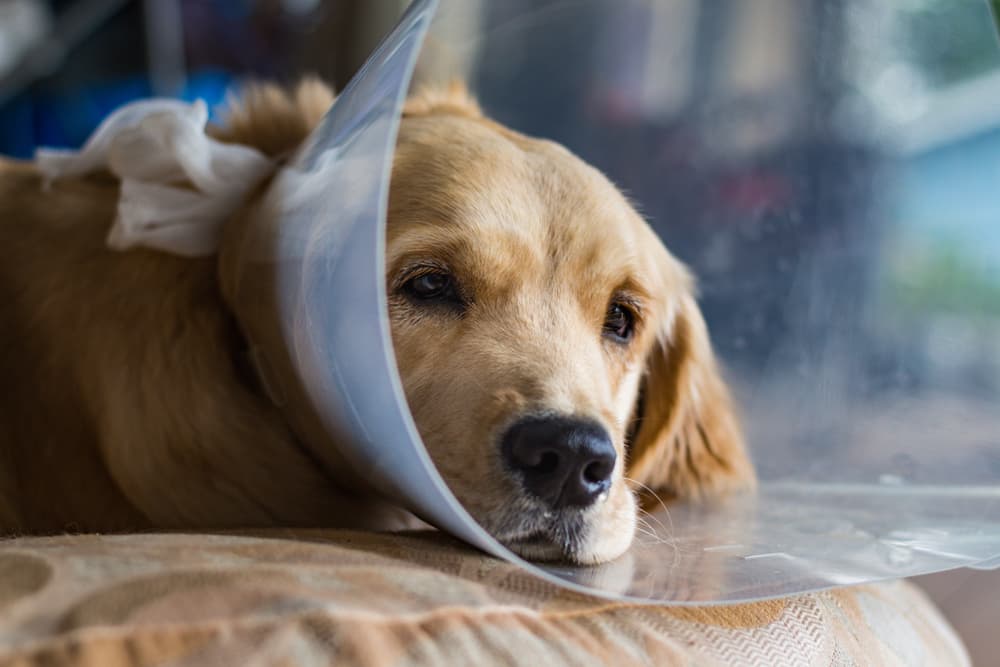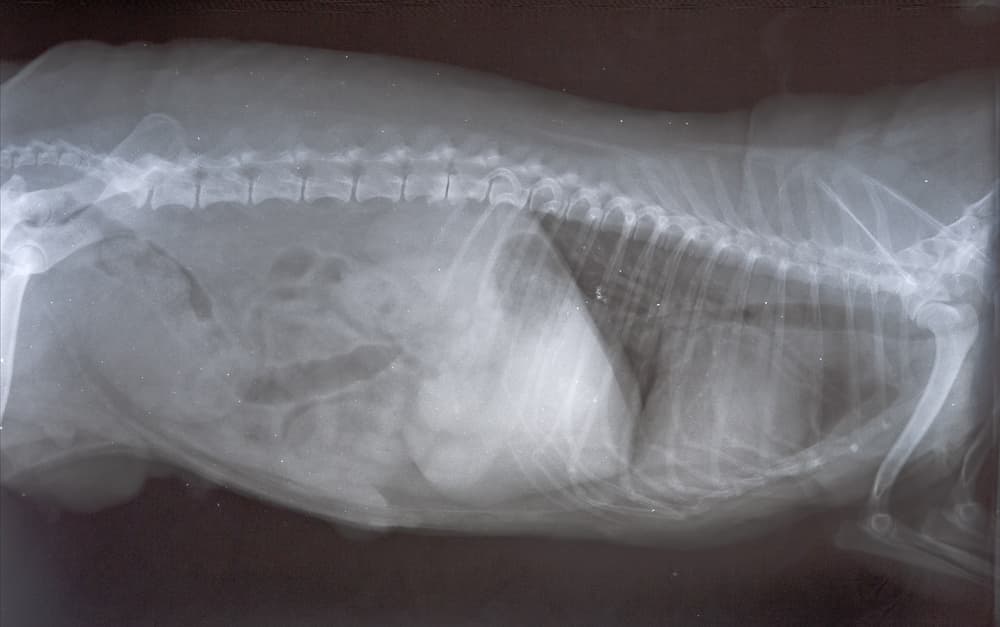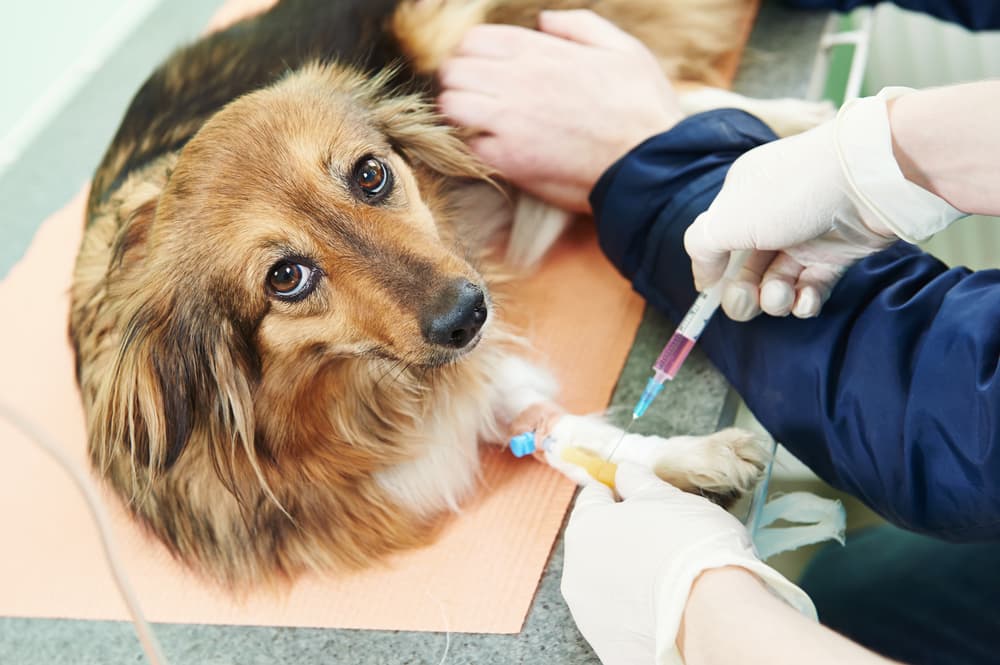Breast Cancer in Dogs

Hearing that your dog has been diagnosed with breast cancer (also called mammary cancer) can be scary and confusing. In the jumble of emotions that follow such a diagnosis, pet parents may wonder what this means for their dog and what happens next. The good news is that breast cancer in dogs is usually not fatal, and about 50 percent of mammary tumors in dogs are benign (1).
The treatment options and prognosis for breast cancer in dogs depend primarily upon the type of tumor they have, as well as its size, location, stage, and other factors.
Here’s a helpful overview that answers the questions pet parents most commonly ask about breast cancer in dogs.
What is Breast Cancer in Dogs?

What some know as breast cancer in dogs, veterinarians more commonly refer to as a mammary tumor or tumors. These tumors are formed by abnormal growth and grouping of cells in canine mammary tissue.
Mammary tumors are most common in female dogs who are intact (un-spayed) or those who were spayed after the age of two. According to data from the California Animal Neoplasia Registry (CANR), mammary tumors account for 41.7 percent of all tumors found in un-spayed dogs (2).
Mammary tumors typically develop in middle-aged and older dogs; they are seldom found in dogs under the age of five. And while mammary tumors can develop in male dogs, this is also quite rare.
Causes of Breast Cancer in Dogs

Hormone exposure is perhaps the greatest factor influencing the development of mammary tumors. Dogs who are spayed early in life have a significantly lower risk of developing mammary tumors, compared with intact females.
One study (3) found the risk of developing mammary tumors to be:
- Less than one percent for female dogs spayed before their first heat cycle
- 8 percent for female dogs spayed after their first heat
- 26 percent for female dogs spayed after their second heat
Certain breeds are also more likely to develop mammary cancer, suggesting a genetic component. Breeds at increased risk include:
- Poodle
- Chihuahua
- Dachshund
- Yorkshire Terrier
- Maltese
- Cocker Spaniel
- English Springer Spaniel
- English Setter
- Brittany Spaniel
- German Shepherd
- Pointer
- Doberman
- Boston Terrier
Obesity, especially prior to puberty, may also increase a dog’s risk of developing mammary tumors later in life.
Symptoms of Dog Breast Cancer

There are several symptoms of dog breast cancer, but the one pet parents commonly notice first is the presence of a mammary tumor or tumors. Typically, pet parents might feel this while petting or grooming their dog, or a veterinarian might discover the lump during a routine physical examination.
These tumors appear as a palpable mass (or masses) in the mammary chain, which is the set of mammary glands along the left or right side of a dog’s body.
Other symptoms of mammary tumors can include:
- Swollen mammary gland or glands
- Discharge from mammary glands
- Pain
- Ulceration of the mammary glands
- Loss of appetite
- Weight loss
- Weakness
- Lethargy
If you notice a mass on your dog’s mammary chain or if your dog has other symptoms of breast cancer, see your veterinarian right away. When it comes to mammary tumors, an early diagnosis can play an important part in helping ensure the best possible outcome for your dog.
Types of Mammary Cancer in Dogs
Mammary tumors can be either benign (non-cancerous) or malignant (cancerous). In dogs with mammary tumors, approximately 50 percent of these tumors are non-cancerous. These benign tumors are also known as adenomas.
However, that means that roughly 50 percent of mammary tumors are cancerous. Malignant mammary tumors are usually carcinomas (cancer occurring in a dog’s internal organs or the skin’s epithelial tissue) or adenocarcinomas (cancer occurring in the glands lining the insides of a dog’s organs).
To determine the type of mammary tumor present, your veterinarian will take a biopsy and submit it for histopathology at a laboratory. This is an important diagnostic step and is the gold standard for diagnosing, classifying, and grading mammary tumors in dogs.
Dog Mammary Cancer Stages and Progression

In addition to sampling the tumor to identify its type, determining the tumor stage is also an important part of diagnosing breast cancer in dogs.
First, veterinarians conduct a physical examination to palpate the mammary chain in search of any additional masses. This also serves to help assess the regional lymph nodes for signs of enlargement. A biopsy of the regional lymph nodes can reveal metastasis, or spread, of the cancer to the lymph nodes.
Your veterinarian should also perform a staging evaluation, including blood work, urinalysis, and x-rays, to determine whether the tumors have spread to the lungs. Veterinarians often recommend abdominal imaging (X-rays or ultrasound) to check for metastasis to other organs.

Armed with all of this information, your veterinarian will then determine the stage of the cancer according to the Tumor-Node-Metastasis (TNM) system. This measurement system was created by the World Health Organization and is considered the standard in veterinary medicine for measuring cancer stages.
In this system, T stands for the size of the tumor, N is the presence of cancer in the regional lymph nodes, and M is the presence of metastasis at distant sites.
The staging includes 5 classifications (4):
| Stage | Tumor Size (T) | Lymph Node Metastasis (N) | Distant Metastasis (M) |
| 1 | Less than 3 cm | None | None |
| 2 | 3-5 cm | None | None |
| 3 | More than 5 cm | None | None |
| 4 | Any size | Present | None |
| 5 | Any size | Any Status | Present |
The lower the number of the tumor’s stage at the time of surgery, the better the chances of a good clinical outcome. A smaller tumor is less likely to recur or metastasize to distant sites. The sooner a mammary tumor is diagnosed and removed, the better the prognosis.
Diagnosing Canine Breast Cancer

Mammary cancer is often first identified when a pet parent or veterinarian feels a lump in a dog’s mammary chain. When that happens, the next step is a thorough physical examination to determine the size of the mass, its exact location, and whether any other masses are present.
Additional diagnostic testing may include:
- Blood Work and Urinalysis. Your veterinarian may require a complete blood count, biochemistry panel, and urinalysis as part of your dog’s staging tests. The results of these tests can confirm whether or not your dog is a suitable candidate for surgery. Your veterinarian may also recommend special blood work, called a coagulation test, to check your dog’s blood clotting factors. These can be abnormal in dogs with mammary cancer.
- Radiography. Your veterinarian may take radiographs (X-rays) of your dog’s chest to check whether the cancer has spread to your dog’s lungs. In some cases, veterinarians may also recommend additional X-rays or an ultrasound of your dog’s abdomen to check other organs for signs of cancer.
- Fine Needle Aspiration and Cytology. Veterinarians may sample the mass using a technique called fine needle aspiration. This allows them to examine cells under a microscope to identify if they indicate the presence of mammary cancer. Your veterinarian may also recommend sampling the regional lymph node or nodes to check for signs that the cancer has spread.
- Biopsy and Histopathology. The gold standard test for diagnosing mammary cancer is taking a biopsy sample and submitting it to a laboratory for histopathology. This allows a pathologist to determine the type of tumor present. To obtain the sample, a veterinarian must remove a portion of tissue for testing (incisional biopsy) or remove and submit the entire mass (excisional biopsy).
Breast Cancer Treatment Options for Dogs

Veterinarians generally recommend surgery as the preferred treatment for most mammary gland tumors in dogs, as long as the cancer has not spread to distant sites. The type of surgery required depends on the size and location of the mammary tumor and the number of mammary glands involved.
Surgery may involve removing the mass and a margin of normal tissue around the mass. Or it may involve removing the entire affected mammary gland. Your veterinarian will determine the best surgical plan for your dog based on your dog’s tumor type, the size and location of the tumor, and the number of tumors to be removed.
Some surgeons recommend spaying at the time of surgery if the dog is intact, but this is controversial. Not all studies have shown an improved survival rate in dogs spayed at the time of mammary tumor removal. However, spaying also prevents other unrelated diseases, such as pyometra (uterine infection). Your veterinarian will discuss the risks and benefits of spaying with you prior to the surgery.

Following surgery, chemotherapy for aggressive mammary carcinoma may be in order. However, specific chemotherapy protocols for mammary carcinoma are not yet standardized and require more study.
Dogs with inflammatory mammary carcinoma tend to be poor candidates for surgery because the microscopic cancer cells typically extend far beyond the palpable mass and, in many cases, have already spread throughout the body. Studies indicate that surgery does not necessarily improve the survival rate in dogs with inflammatory carcinoma. The most effective treatments for inflammatory carcinoma are currently radiation therapy and treatment with a non-steroidal anti-inflammatory drug (NSAID). However, even with these treatments, the overall prognosis is poor.
Cost to Treat Breast Cancer in Dogs
The cost to treat mammary cancer in dogs depends on the tumor type, size, location, grade, stage, and recommended treatment options. In general, pet owners should expect to spend $1,500-3,000 on surgery for mammary cancer, depending on the severity of the tumor and the type of surgery involved. Additional costs may be incurred for radiation therapy or chemotherapy following surgery.
Prognosis for Breast Cancer in Dogs

There are several factors that impact the prognosis for dogs with mammary tumors. Those with mammary tumors measuring less than 3 cm typically live longer than those with larger tumors. Dogs whose masses are removed with complete margins (meaning no microscopic cancer cells remain) also have a better prognosis than dogs with incomplete mass removal.
Prognosis also worsens as the tumor stage advances; dogs with smaller, localized tumors generally do better than those with lymph node involvement or distant metastasis. Other factors, such as tumor type and grade, also influence prognosis. Most importantly, pet owners should be aware that dogs with one mammary tumor are also likely to develop additional mammary tumors.
How to Prevent Breast Cancer in Dogs
Spaying prior to the first heat significantly reduces the risk of developing mammary tumors later in life. Maintaining a healthy lean body weight may also reduce mammary tumor risk. And, since early detection and treatment can play an important role in the outcome, it’s best to talk with your veterinarian about any abnormal lumps you detect on your dog, especially in the mammary chain.
References
- Canine Mammary Tumors. The Ohio State University Veterinary Medical Center. vet.osu.edu.
- Dorn CR, Taylor DO, Schneider R, et al. Survey of animal neoplasms in Alameda and Contra Costa Counties, California. II. Cancer morbidity in dogs and cats from Alameda County. J Natl Cancer Inst 1968;40:307–318.
- Schneider R, Dorn CR, Taylor DO: Factors influencing canine mammary cancer development and postsurgical survival. J Natl Cancer Inst 1969 Vol 43 (6) pp. 1249-61.
- Nunes FC, Damasceno KA, de Campos CB, et al. Mixed tumors of the canine mammary glands: Evaluation of prognostic factors, treatment, and overall survival. Veterinary and Animal Science, 2019;7.doi.org/10.1016/j.vas.2018.09.003.









